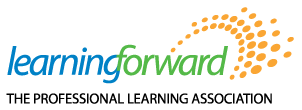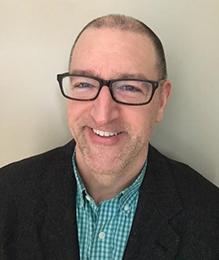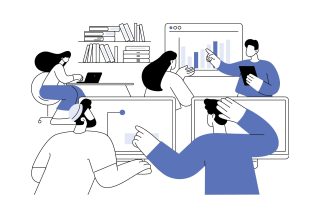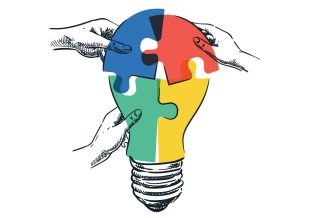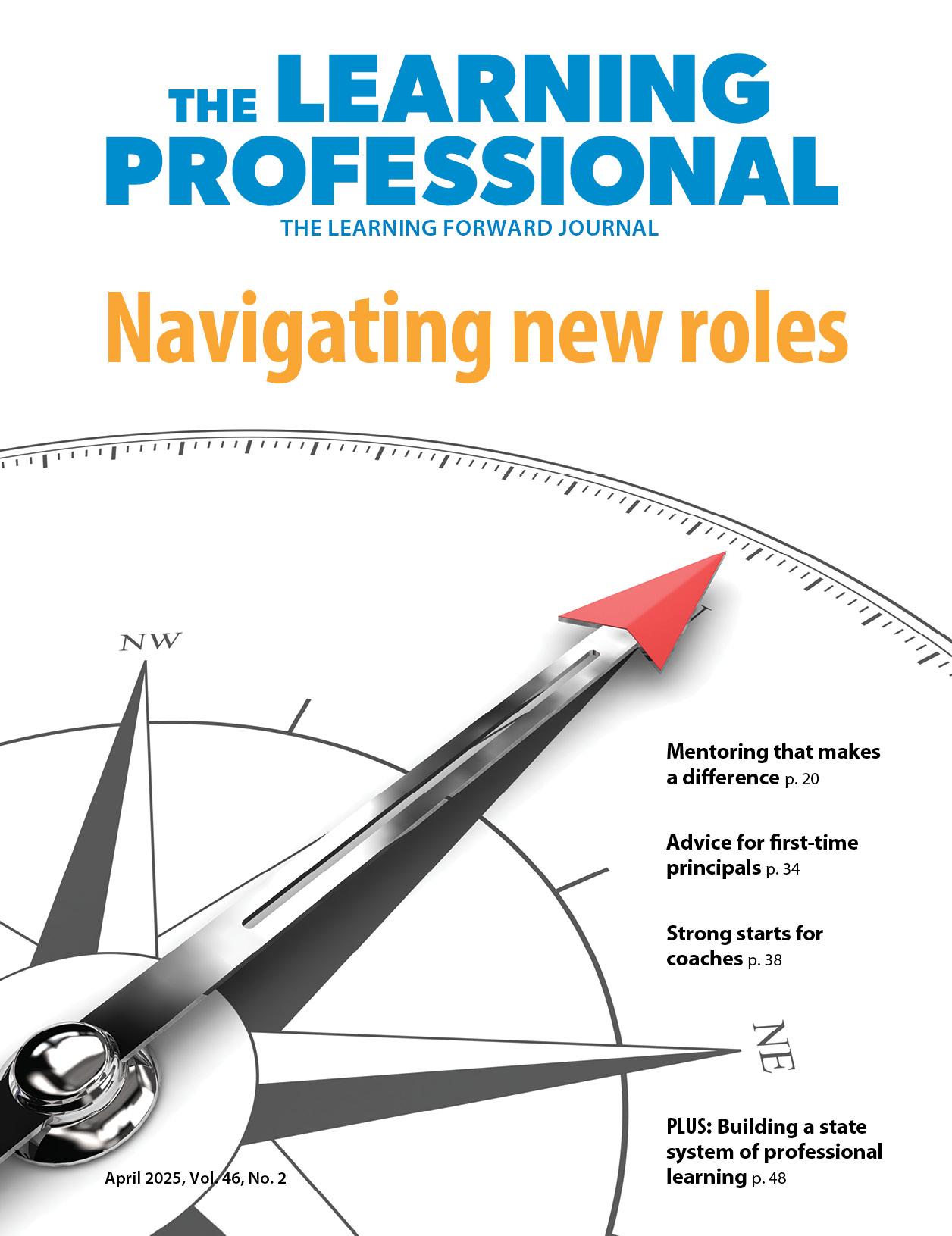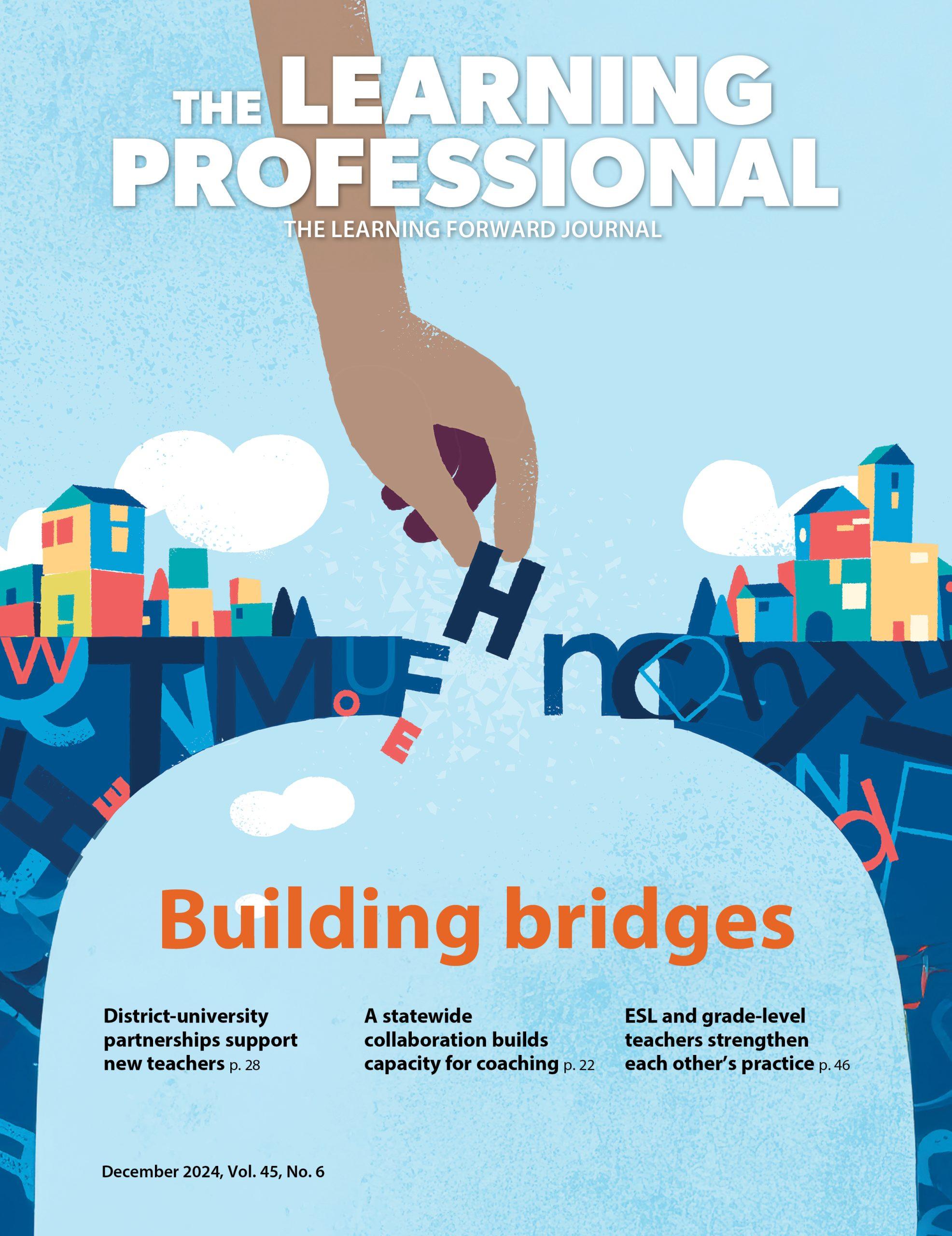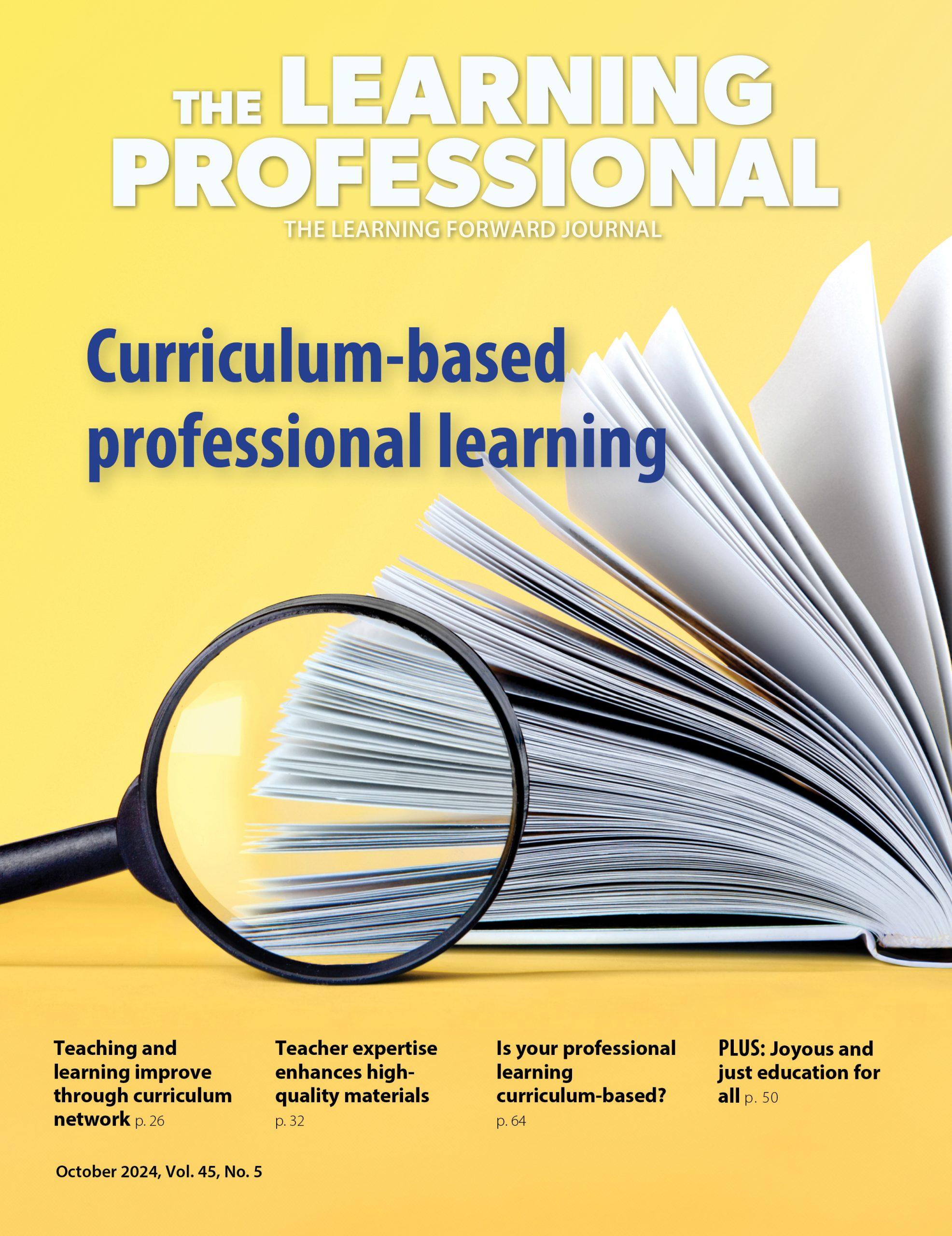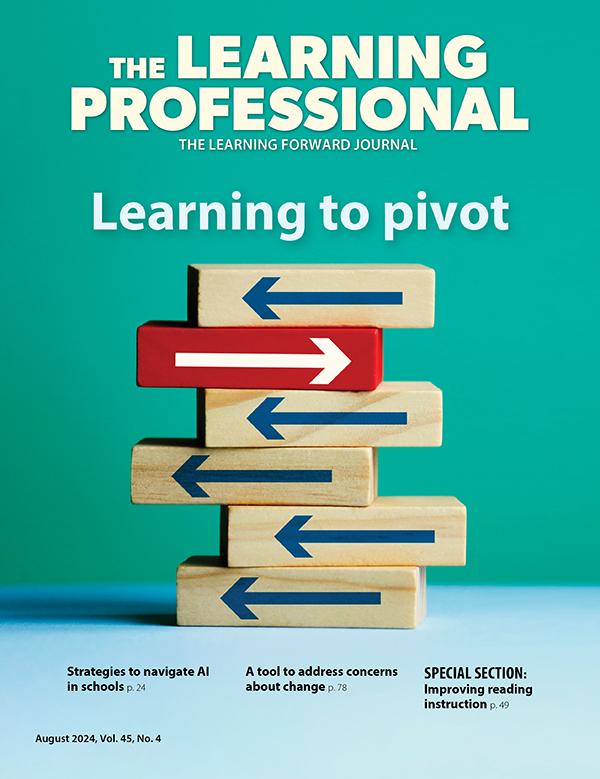FOCUS
Teachers and coaches learn together at Boston’s learning sites
By Kristen Cacciatore and Mark Lonergan
Categories: Learning communities, Learning designs, OutcomesFebruary 2025
Biology teacher Sarah Benat stood at the front of her classroom at Boston’s Brighton High School, instructing students about graphing terms while moving her arm in the shape of increasing, decreasing, and constant lines on a graph. Her 12 English learner students repeated her arm movements with a chorus of matching vocabulary words.
This could have been any day in Ms. Benat’s 10th-grade biology class for multilingual students, but this day was special. Fifteen educators from schools all over Boston, including members from Boston Public Schools’ science and multilingual learner central office staff departments, had come for a 45-minute observation.
The observation is the anchor activity for a learning site, a professional learning series designed to support teachers in making instructional improvements aligned with self-identified needs and districtwide instructional goals. Learning sites are one of the core professional learning offerings by a team of teacher leaders in Boston Public Schools called the Telescope Network.
Benat’s learning site was one of 49 professional learning events offered by the Telescope Network in 2023-24 that served 647 educators across 102 schools, including 255 educators of color. The learning sites spanned all grade levels, content areas, and student subgroups, addressing a wide range of instructional challenges including meeting diverse student needs, increasing cultural responsiveness, and encouraging collaborative co-teaching. An explicit goal of the network is to elevate educators of color and provide them with opportunities to model instructional leadership.
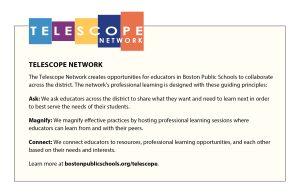
The network’s aim is to weave together the collective expertise of classroom teachers and district instructional coaches that exemplify meaningful, connected professional learning for educators. In Benat’s site and similar sites across the district over the past few years hundreds of Boston educators have observed an effective peer and have integrated new teaching strategies into their practice.
NEEDS ASSESSMENT SURVEY IS THE FIRST STEP IN SITE DESIGN
Designing Benat’s learning site was a year-long, intentional process with a considerable amount of prep work on top of a half-day peer observation and several follow-up sessions. It began with assessing educators’ instructional challenges and specific learning needs from the classroom-based educators’ perspective. Twice per year a districtwide needs assessment survey is given to all teachers and staff, central office personnel, school-based coaches, school leaders, and district leaders. The spring 2024 survey was completed by more than 700 individuals, representing more than 10% of educators across the district.
The survey questions include open-ended items where educators describe their challenges and successes as well as a few selected-response questions to rank the relevance and importance of district instructional initiatives in their context. Survey responses are analyzed to identify the most significant learning needs of different subgroups of educators, such as middle school math teachers or educators of color, and how those learning needs relate to current district initiatives. A following analysis is used to identify focal areas and audiences for professional learning offerings over the subsequent six months and shared with instructionally focused central office staff. The survey also asks educators to recommend colleagues who are doing excellent work.
While immensely valuable as a tool for gauging a broad range of educators’ needs, this assessment survey is not detailed enough to understand those needs in depth. To gain a more complete understanding, a smaller group of educators participates in interviews and focus group conversations to share more about what makes their work especially challenging, what strategies they use to address those challenges, and what makes professional learning opportunities more (or less) helpful. Similarly, central office personnel and other stakeholders participate in dialogues about their departments’ professional learning offerings and their perceptions of educator needs.
In recent years, supporting multilingual learners across a wide range of grade levels and contexts has been a dominant theme in teachers’ self-identified needs and district instructional priorities. Teachers report these students sometimes struggle to access the required curricula and are often unable to make progress independently on tasks. Nearly 40% of responses (see p. 41) on the spring 2024 needs assessment survey cited challenges of adapting curriculum for high-needs students, with many respondents specifically mentioning multilingual learners.
District-level coaches who focus on English learners report they observe many educators who are not implementing the recommended, supportive instructional strategies for this student subgroup. District science coaches are concerned that teachers are reluctant to use the district’s curriculum, which centers oral student discourse as a key driver for learning. School and district leaders, meanwhile, are intensely focused on closing achievement gaps between the growing population of multilingual learners and other students in the district, one of the current overarching priorities for Boston Public Schools. Learning sites are a way to weave these different priorities together by anchoring the learning in a classroom observation of a teacher who is using the new science curriculum and having success with students who are multilingual learners.
LAYING THE GROUNDWORK FOR LEARNING SITES
After a learning site’s focus area is clarified, the next step is to identify host teachers, recruit them to lead peer learning, and prepare them to open their thought processes and classrooms to colleagues from around the district. Benat was recommended by coaches in the district’s multilingual learner office and by a science teacher leader familiar with her work. Her practice was noteworthy for high levels of student engagement and learning and for addressing the challenges of serving multilingual learners, effectively using the science curriculum, and successfully fostering student-to-student dialogue, all high priority problems of practice. Telescope Network’s Alison Mosher explained, “We want to find ‘humble expert’ teachers who are effective and reflective.”
Benat’s classroom learning site provided educators with the structure to collaborate on the modeling and learning of effective, high-leverage practices for English learners in science. The planning team identified this site’s guiding question: “How do we provide access to Tier 1 science curriculum for multilingual learners?” Benat collaborated with a coach, or networker, to develop a driver diagram (see page 42), a visual map that shows connections between the aim, strategies for reaching it, and specific practices to enact those strategies. In her case, this was teaching biology to multilingual students.
NETWORK COACHES CONNECT THEORY AND PRACTICE
The learning sites are developed by a group of 10 veteran educators at the Telescope Network whose work is co-sponsored by the district and the Boston Teachers Union. The networkers support and guide this collaborative work, leveraging district knowledge and expertise that has historically been siloed.
In their hybrid role, networkers spend two days each week assigned to a school, most often in an instructional coach capacity. They spend the other three days supporting educators across the district. This arrangement allows networkers to stay ingrained in the lived reality of schools and bring that understanding to their work in the central office and throughout the district.
Benat examined the driver diagram with her networker and district coaches and suggested revisions to emphasize the importance of academic language supports that are aligned to students’ levels of English proficiency. They selected a lesson to demonstrate supports such as call-and-response and other speaking routines. Before visitors arrived for the observation, Benat knew what she would be teaching and why. Creating the driver diagram was a means of articulating the connection between her classroom practices and the theory behind them.
KICKING OFF THE VISIT AND REFLECTING ON THE LEARNING
The day before the classroom observation, the learning site experience kicked off with a virtual pre-session to orient participants to the planned lesson structure, how instructional challenges would be addressed, and how this might align with their teaching contexts and experiences. Each participant chose an observation focus from Benat’s driver diagram, such as academic language supports or students’ independent use of resources.
After the 45-minute observation the next day, the group debriefed the experience in two stages. First, participants met in small groups to identify connections between teacher moves and positive impacts on students. Each small group also generated an excavating question to better understand the teacher’s rationale and decision-making processes. Excavating questions are designed to push the host teachers to think about the embedded but not always visible “hows” and “whys” behind their instruction. This might include queries such as “What are you thinking about when you ___?” or “How else have you done this before?”
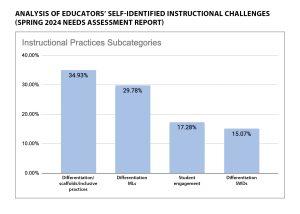
The small group that focused on academic language supports noted that the student handout for the lesson used sentence stems as scaffolds, which were gradually removed as students progressed through the questions. They noticed how students were able to produce complete, correct sentences without that support by the end of the lesson by referring back to the earlier questions and having conversations.
The observing educators agreed that seeing real-time, strategic use of sentence stems by students was powerful. One said, “Seeing it is so different from hearing about what to do at a meeting. You go to these professional learning sessions and people tell you to do things like ‘use academic language supports,’ but until you see what it should look like you don’t know what to do or believe that it matters.”
When the whole group met with Benat, each small group shared their reflections and asked their excavating questions. During the debrief Benat also discussed how she might measure this lesson’s success and how to guide a novice teacher with a similar population of students, among other topics.
APPLYING NEW LEARNING
Each educator made a plan for integrating this learning into their teaching practice. With the support from the networker and the use of a template, participants selected a small, specific change to try out with their students that was connected to the strategies observed in the host teacher’s classroom. Participants made a prediction about the impact of that change and identified a tool to monitor its implementation. Five participants chose to focus on the gradual release of sentence stems as shown with Benat’s example. Five others planned to concentrate on routines for checking for understanding, and four educators chose other aspects of their practice to improve. One person chose not to continue with the virtual coaching sessions after the site visit, and did not select a change idea.
Over the following six weeks, the learning site participants implemented and refined their change ideas through the coaching and peer feedback process. Participants reconvened virtually three times at two-week intervals to share their progress on implementing their change ideas. During these one-hour virtual meetings, the educators gave and received advice and feedback from peers and made adjustments to their plan for the next two-week cycle. At the final meeting, each educator completed a reflection to capture their learning, decided if they would adopt their change idea, and considered next steps.
For example, one second-year educator implemented the gradual release of sentence stems and tracked students’ use. She found that by the end of the cycle 100% of her students were successfully using them and more than 80% were able to do so independently. Other participants documented positive impacts on students through the implementation of their change ideas, all of which aligned with the high-leverage moves the district multilingual coaches and the host teacher had identified as drivers of student learning.
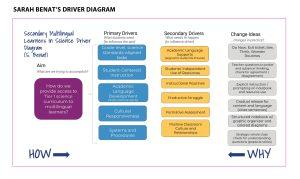
BENEFITS OF THE NETWORK
Response to the learning site experience has been overwhelmingly positive. Ninety-eight percent of participants stated they would recommend participation to a colleague. This was considerably higher than the 50% of Boston Public Schools educators who, per a 2024 Panorama teacher climate survey (Boston Public Schools, 2024), gave favorable ratings to the district’s professional learning overall.
A 2023 study conducted by Wheelock Educational Policy Center at Boston University examined the benefits of learning sites. Participants cited the opportunity to collaborate with colleagues across schools on a shared instructional challenge as a distinguishing, positive feature of this professional learning compared to other experiences (Tichnor-Wagner & Ferro, 2023). Going forward, the Telescope Network aims to gain a systemic understanding of the impact of learning sites on student learning across all participating educators’ classrooms.
As a result of this work, many educators have made changes in their instructional practices that are associated with student benefits. One participant at Benat’s site said, “Talking with other teachers about my idea is one of the reasons I’ve kept doing it and found little ways to keep improving. Sometimes when you’re just grinding through, you forget that you can change things, even little things like this!”
Benat is drawing from this teacher leadership experience to support herself with the implementation challenge of the district’s new biology curriculum. “The learning site really helped me reflect on why I do what I do and to know what things are important to carry forward as I start using OpenSciEd. It was a powerful experience — so affirming and also insightful.” She hopes to engage in another learning site opportunity in the near future.
Download pdf here.
References
Boston Public Schools. (2024). BPS Staff Survey. secure.panoramaed.com/bps/understand/5590592/summary#topic-scores-employee
Tichnor-Wagner, A. & Ferro, A. (2023). Networked professional learning to empower educators and improve student outcomes: Findings from the Telescope Network 2022-23 Learning Sites and Cohort [Unpublished report]. Wheelock Educational Policy Center, Boston University.
Categories: Learning communities, Learning designs, Outcomes
Recent Issues
LEARNING DESIGNS
February 2025
How we learn influences what we learn. This issue shares essential...
BUILDING BRIDGES
December 2024
Students benefit when educators bridge the continuum of professional...
CURRICULUM-BASED PROFESSIONAL LEARNING
October 2024
High-quality curriculum requires skilled educators to put it into...
LEARNING TO PIVOT
August 2024
Sometimes new information and situations call for major change. This issue...
